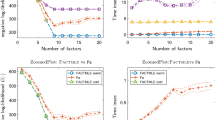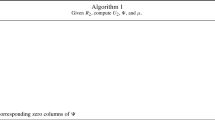Abstract
For any given number of factors, Minimum Rank Factor Analysis yields optimal communalities for an observed covariance matrix in the sense that the unexplained common variance with that number of factors is minimized, subject to the constraint that both the diagonal matrix of unique variances and the observed covariance matrix minus that diagonal matrix are positive semidefinite. As a result, it becomes possible to distinguish the explained common variance from the total common variance. The percentage of explained common variance is similar in meaning to the percentage of explained observed variance in Principal Component Analysis, but typically the former is much closer to 100 than the latter. So far, no statistical theory of MRFA has been developed. The present paper is a first start. It yields closed-form expressions for the asymptotic bias of the explained common variance, or, more precisely, of the unexplained common variance, under the assumption of multivariate normality. Also, the asymptotic variance of this bias is derived, and also the asymptotic covariance matrix of the unique variances that define a MRFA solution. The presented asymptotic statistical inference is based on a recently developed perturbation theory of semidefinite programming. A numerical example is also offered to demonstrate the accuracy of the expressions.
Similar content being viewed by others
References
Bentler, P.M., & Woodward, J.A. (1980). Inequalities among lower bounds to reliability: With applications to test construction and factor analysis.Psychometrika, 45, 249–267.
Bonnans, J.F., & Shapiro, A. (2000).Perturbation analysis of optimization problems. New York, NY: Springer-Verlag.
Browne, M.W. (1974). Generalized least squares estimators in the analysis of covariance structures.South African Statistical Journal, 8, 1–24.
Carroll, J.B. (1993).Human cognitive abilities: A survey of factor analytic research. New York, NY: Cambridge University Press.
Guttman, L. (1958). To what extent can communalities reduce rank?Psychometrika, 23, 297–308.
Harman, H.H. (1967).Modern factor analysis. Chicago, IL: The University of Chicago Press.
Harman, H.H. & Jones, W.H. (1966). Factor analysis by minimizing residuals (minres).Psychometrika, 31, 351–368.
Jöreskog, K.G. (1967). Some contributions to maximum likelihood factor analysis.Psychometrika, 31, 443–482.
Ledermann, W. (1937). On the rank of reduced correlation matrices in multiple factor analysis.Psychometrika, 2, 85–93.
Rao, C.R. (1973).Linear statistical inference and its applications. New York, NY: Wiley.
Saigal, R., Vandenberghe, L. & Wolkowicz, H. (Eds.). (2000).Semidefinite programming and applications handbook. Boston, MA: Kluwer Academic Publishers.
Schutz, R.E. (1958). Factorial validity of the Holzinger-Crowder Uni-Factor Tests.Educational and Psychological Measurement, 18, 873–875.
Shapiro, A. (1982). Rank reducibility of a symmetric matrix and sampling theory of minimum trace factor analysis.Psychometrika, 47, 187–199.
Shapiro, A. (1985). Identifiability of factor analysis: Some results and open problems.Linear Algebra and its Applications, 70, 1–7.
Shapiro, A. & ten Berge, J.M.F. (2000). The asymptotic bias of Minimum Trace Factor Analysis, with applications to the greatest lower bound to reliability.Psychometrika, 65, 413–425.
ten Berge, J.M.F. (1998). Some recent developments in factor analysis and the search for proper communalities. In A. Rizzi, M. Vichi, & H.H. Bock (Eds),Advances in data science and classification (pp. 325–334). Heidelberg, Germany: Springer.
ten Berge, J.M.F. (2000). Linking reliability and factor analysis:recent developments in some classical psychometric problems. In S.E. Hampson (Ed.),Advances in personality psychology, Vol. 1 (pp. 138–156). London, England: Routledge.
ten Berge, J.M.F. & Kiers, H.A.L. (1991). A numerical approach to the exact and the approximate minimum rank of a covariance matrix.Psychometrika, 56, 309–315.
ten Berge, J.M.F., Snijders, T.A.B. & Zegers, F.E. (1981). Computational aspects of the greatest lower bound to reliability and constrained minimum trace factor analysis.Psychometrika, 46, 201–213.
Author information
Authors and Affiliations
Corresponding author
Additional information
This work was supported, in part, by grant DMS-0073770 from the National Science Foundation.
Rights and permissions
About this article
Cite this article
Shapiro, A., ten Berge, J.M.F. Statistical inference of minimum rank factor analysis. Psychometrika 67, 79–94 (2002). https://doi.org/10.1007/BF02294710
Received:
Revised:
Issue Date:
DOI: https://doi.org/10.1007/BF02294710




